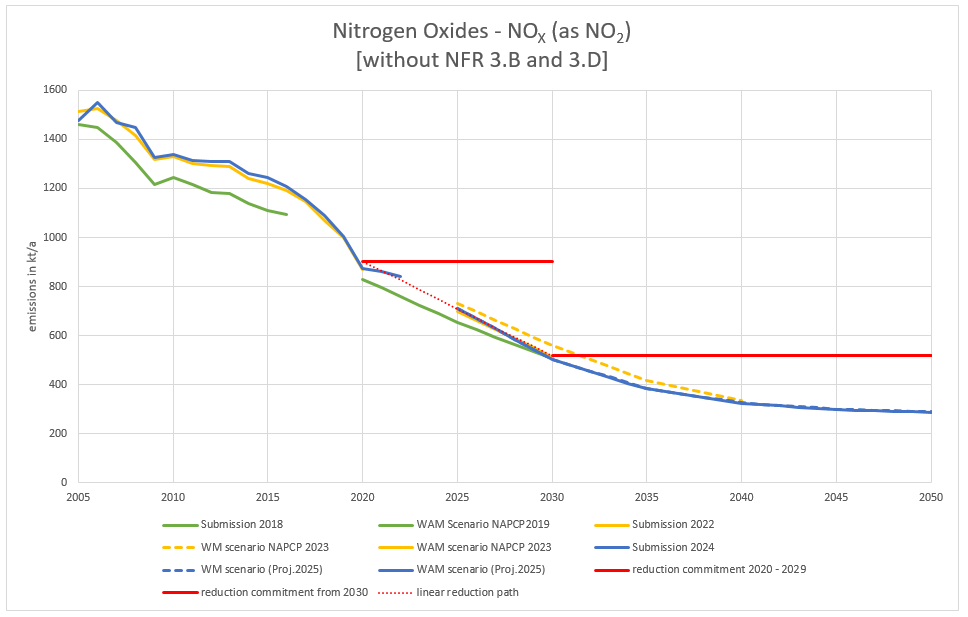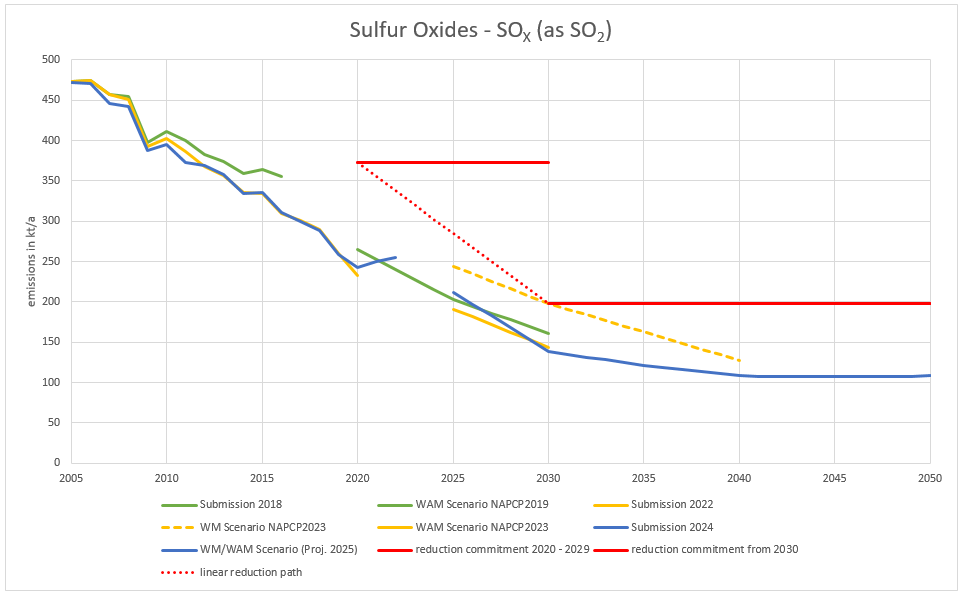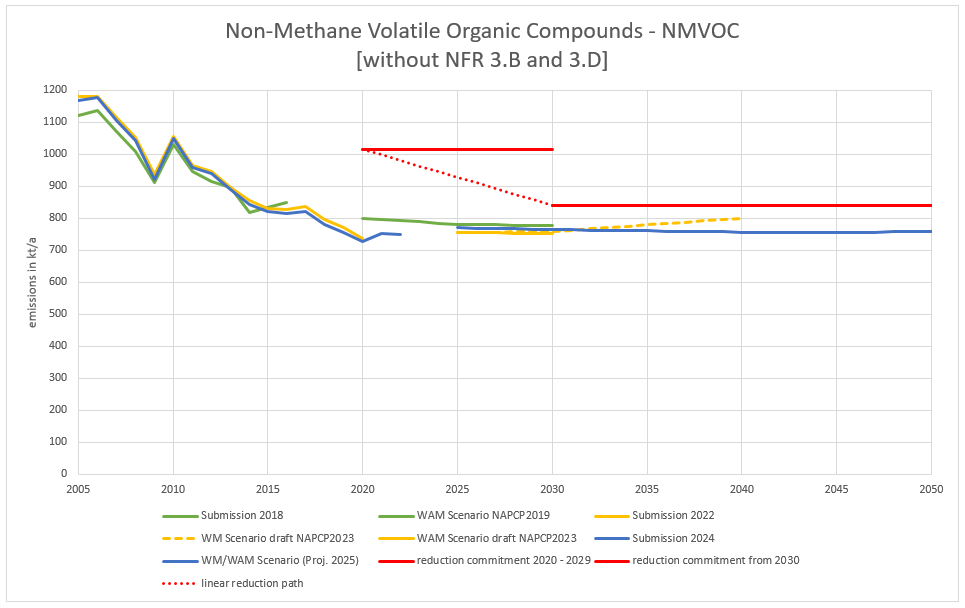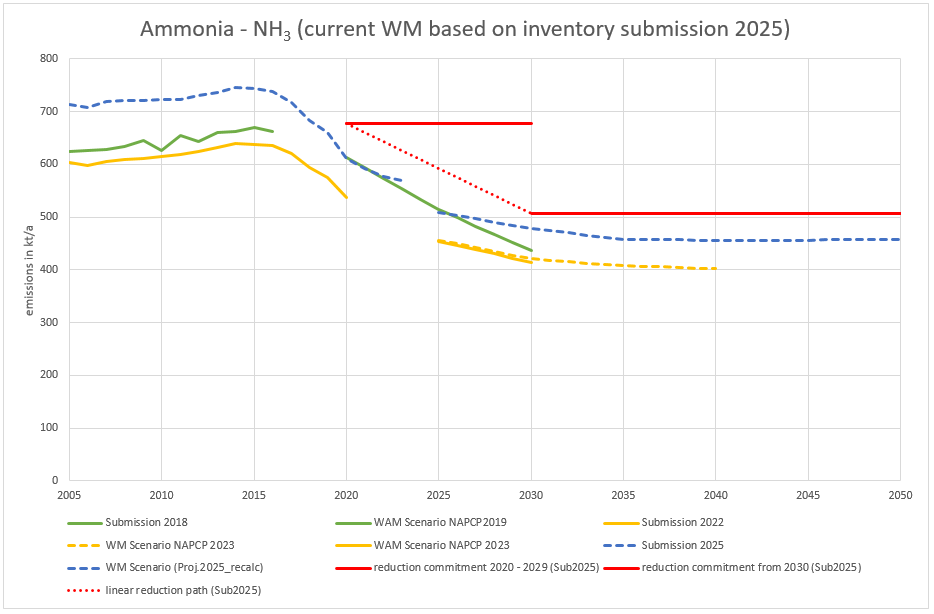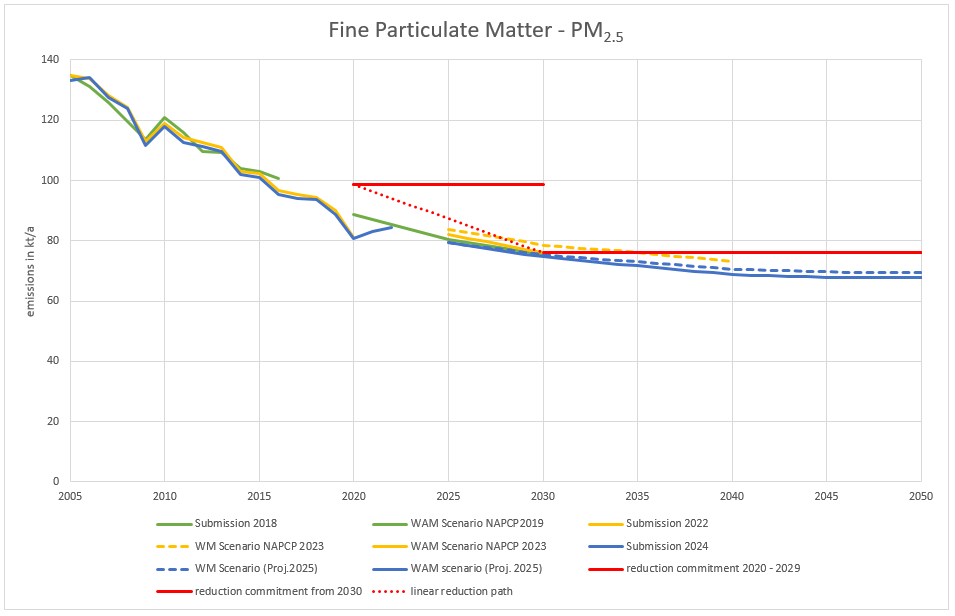meta data for this page
Recalculations
Due to recalculations in each underlying emission inventory submission, all calculations of emission reduction potentials in the WM and WAM scenario of the respective projection are regularly updated. Furthermore, additional measures that had been included in the WAM scenario in the previous projection can become part of the WM scenario in the current projection, as they were put into force in the meantime (e. g. amendment of the 17th BImSchV). In addition, updated GHG emission projections using most recent projections of economic and other parameters result in a new projection of activity rates that needs to be considered for updating the emission projections of air pollutants. For the regular update of the projections under NEC-Directive (EU) 2016/2284, in between the regular update of the National Air Pollution Control Programme every four years, remaining measures in the WAM scenario of the current NAPCP stay and their mitigation potential is reassessed, unless they were dropped by the current federal government. The last is the case for the package of additional agricultural measures in the WAM scenario of the German NAPCP 2023. Thus, it was not reassessed for the current projections.
For each pollutant the following figures show the differences between inventory submissions 2018, 2022 and 2024 for historic emissions as well as the differences between the WAM emission projections reported in 2019 (consistent with the NAPCP 2019), the WM and WAM scenario reported in 2023 (consistent with the NAPCP 2023) and the current WM and WAM scenario reported in 2025. For each pollutant a brief explanation of the most relevant reasons for the occurring differences compared to the previous reporting is given. For explanation of the differences between reporting in 2023 as well as the NAPCP 2023 reported in 2024 and 2021 please see IIR 20241) and for the differences between reporting in 2021 and 2019 please see the IIR of the 2021 reporting2).
In general, there is not much change in the current projection for NOX, that needs further explanation. Apart from the recalculations in the inventory since submission 2018, explaining most of the differences in 2025 between the NAPCP 2019 projection and the more current projections, there are two relevant reasons for differences between the current WM projection and the previous WM projection of the NAPCP 2023:
- The coal phase-out until 2030 is now included in the WM projection. To some extent because of legislation that did take place in the meantime and to some extent because of updated assumptions on price development of fuels, prices at the energy market as well as for CO2-prices, making especially the power generation from lignite in the remaining capacities less and less economical.
- Second, most measures from the road transport package of the NAPCP 2023 are now part of the WM scenario as they entered into force in the meantime (e. g. amended truck toll, Euro 7 legislation). There is neither further increase of the share of electrically driven mileage for passenger cars nor further increase of the number of passenger cars in the fleet assumed beyond the WM scenario (for description of assumptions in the road transport sector in the current WM scenario see calculation documentation and referred publications).
There is also not much change in the current projection for SOX, that needs further explanation. There is only one relevant reason for differences between the current WM projection and the previous WM projection of the NAPCP 2023:
- The coal phase-out until 2030 is now included in the WM projection. To some extent because of legislation that did take place in the meantime and to some extent because of updated assumptions on price development of fuels, prices at the energy market as well as for CO2-prices, making especially the power generation from lignite in the remaining capacities less and less economical. In the WM scenario of the NAPCP 2023 this was assumed to take place until 2038 (see description of the previous WM scenario in the IIR 2024).
NMVOC emission projections are strongly influenced by economic projections. Updates on these are therefore causing changes in NMVOC emission projections. The deviating trend of the current WM projection against the previous WM projection of the NAPCP 2023 is explained in the chapter calculation documentation. However, the latest historic emissions in 2022 are already below the current WM projection for 2025 to 2050, which is caused by decreases over all sectors.
For ammonia (NH3) two comparisons to previous projections are shown as two WM projections were submitted under NEC-Directive & CLRTAP in 2025, one based on inventory submission 2024 and the other one based on inventory submission 2025 under otherwise identical assumptions. In both cases, from submission 2021 onwards a methodological change in emission calculations for inorganic fertilisers is leading to less variation from one year to another3). Apart from that, current WM projection based on inventory submission 2024 is slightly above the previous WM and WAM scenarios of the NAPCP 2023 in 2030 and beyond as there are slight changes in the assumptions on animal numbers and thus, in the amount of manure and inorganic fertilisers applicated. The current WM projection based on inventory submission 2025 is significantly higher, due to recalculations in the inventory. The main reason for higher emissions are adjusted emission factors for various inorganic fertilisers according to the latest EMEP/EEA air pollutant emission inventory guidebook 2023. Development of historic emissions and projections in the current WM scenario (in both variations) is not parallel, as the amount of fertilisers is multiplied with the emission factors and therefore difference in resulting emissions is not linear.
PM2.5 projections are mostly consistent over the various projection reportings. However, the projection of the NAPCP 2019 and later projections are containing mutually compensating assumptions. The WAM scenario of the NAPCP 2019 had assumed a much higher coal use as well as a much lower use of solid biomass in 2030 than the following projections, leading to an almost congruent estimate of the projected national PM2.5 total. Thus, the WM scenario of the NAPCP 2023 lies above all other displayed scenarios, because of higher biomass use than in the WAM scenario of the NAPCP 2019 (and also than in the current WM and WAM scenarios) in combination with a lower coal use than in the NAPCP 2019.
However, the assumed coal use in the current WM scenario is almost phased out until 2030 (see description in the WM scenario) in combination with an assumed use of solid biomass that is lower than in the NAPCP 2023 but higher than in the NAPCP 2019. That the WAM scenario of the NAPCP 2023 is also slightly above the current WM projection in the year 2025 is mostly due to a previously projected sharper increase in the use of solid biomass in the building sector than under updated assumptions. Apart from these differing assumptions of coal use in the energy and industry sector and the use of solid biomass in the building sector as well as in the energy and industry sector, also updated assumptions in the road transport sector have a mitigation effect (e. g. Euro 7 regulation introducing limit values for tyre and brake wear). With less biomass in the current WM scenario than in the NAPCP 2023 also the mitigation potential of the revision of the Ecodesign directives for solid fuel boilers and solid fuel local space heaters in the current WAM scenario is slightly lower than in the previous WAM scenario of the NAPCP 2023.


